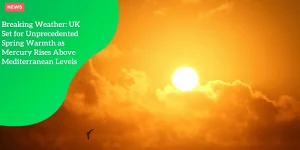Breaking: Yellow Wind Warnings Cover Most of UK as Storm Éowyn Threatens with ‘Weather Bomb’ Conditions
Anúncios
Storm Alert and Warnings
Brace yourselves, folks!
The Met Office has named Storm Éowyn as the fifth named storm of the season, and it’s expected to pack quite a punch.
Anúncios
Get ready for some wild weather, as yellow wind warnings have been issued for most of the UK.
These warnings are set to last from midnight on Thursday until Saturday, covering Scotland, Northern Ireland, Wales, and much of England.
Anúncios
Meteorologists have warned that this storm could bring severe weather conditions across a vast swathe of the country. So, what can we expect?
Well, inland areas might see gusts of 50-60 mph, while coastal regions could get battered by winds of 70-80 mph.
This means there’s a real risk of flying debris and potential damage to buildings, which may include anything from roof tiles to even larger objects being dislodged.
Broader Impact of Storm Éowyn
The Met Office has also highlighted that the incoming storm will bring some heavy rainfall across the affected regions.
This could lead to localized flooding, particularly in northern areas, putting a dampener on travel plans and outdoor activities. Additionally, there’s a possibility of snowfall in the north, adding another layer of disruption.
According to Andrea Bishop, a spokeswoman for the Met Office, Storm Éowyn is forecasted to bring quickly deteriorating conditions on Friday, starting with the north-western parts of the UK.
“Pronounced ‘Ay-oh-win’, the system will begin to influence the UK’s weather on Friday, with strengthening winds initially in north-western parts of the UK with accompanying heavy rainfall”.
The yellow weather warnings issued are in effect from midnight on Thursday until noon on Saturday, particularly affecting Northern Ireland, the Scottish Highlands, and western Scotland.
As always, the Met Office advises everyone to stay tuned to their local forecasts for updates on potential changes in the storm’s behavior.
Preparing for the Storm
With the storm looming, it’s crucial to prepare for the adverse weather conditions.
Make sure to secure loose objects around your home, including garden furniture and anything that could be blown away by strong gusts.
Check that your car is ready for challenging driving conditions, and if you’re planning to travel, stay updated on the latest weather and traffic reports.
The strong winds are likely to cause some disruption, so plan ahead and allow extra time for your journeys.
Public services may also be affected, including road, rail, air, and ferry services.
If you’re traveling, make sure to keep an eye on service updates.
Conclusion
Storm Éowyn is ready to make its presence felt, and it’s shaping up to be a significant weather event.
The Met Office’s warnings are in place to give everyone time to prepare and stay safe.
As we brace ourselves for the storm, it’s essential to keep informed and take necessary precautions to minimize the impact on our daily lives.
Stay safe and stay alert for further updates from the Met Office.
This chapter highlights the need for preparedness and caution as Storm Éowyn approaches.
In tune with ongoing updates, make sure to stay informed and ready for any further developments of the storm.
Expected Wind Conditions
Inland Areas
As Storm Éowyn approaches, the inland areas of the UK are preparing for significant wind events.
Forecasters predict gusts ranging between 50-60 mph, which is substantial enough to disrupt daily life.
These high winds carry the risk of causing flying debris, which can lead to damage to buildings and other structures.
It’s essential for residents to secure any outdoor objects that could become projectiles in these conditions.
Additionally, the wind’s force might lead to large tree branches breaking and potentially leading to power outages or road obstructions.
Coastal Regions
The coastal regions are likely to experience even more extreme wind conditions.
With gusts expected to reach between 70-80 mph, the impact will be profound.
The heavy winds in coastal areas have the potential to cause structural damage, especially to weaker buildings and temporary structures.
The intensity of these gusts could result in boats being pulled from moorings and significant coastal erosion.
Residents in these areas are advised to follow local authority guidance to ensure their safety and property protection.
General Risks
The overall risk associated with these wind conditions includes potential damage to infrastructure and a heightened danger from flying debris.
Fast-moving debris can cause serious injury to people and animals, and it can also lead to secondary damage by breaking windows or impacting vehicles.
To mitigate these risks, it is highly advisable to remain indoors during the peak wind periods and offer assistance to vulnerable neighbors and community members if safe to do so.
Regular updates from the Met Office and local news should be monitored to stay informed about the storm’s progression and any changes in the warnings.
Anticipating the storm’s arrival means preparing for these severe wind conditions and taking proactive measures to ensure personal and property safety.
This alert serves as a reminder of the potential hazards we face and underscores the importance of preparedness.
Weather Bomb Formation
Storm Éowyn’s arrival in the UK is a result of explosive cyclogenesis in the Atlantic.
You might be wondering, what exactly does that term mean? To put it simply, explosive cyclogenesis—or a “weather bomb”—occurs when a storm rapidly intensifies due to a major drop in atmospheric pressure.
Specifically, this happens when the pressure drops by 24 millibars or more within 24 hours.
For Storm Éowyn, this steep pressure decline is predicted to make the storm much stronger and more impactful by the time it hits the UK.
The Driving Forces
The explosive cyclogenesis of Storm Éowyn is caused by the interaction between different weather systems.
A significant factor is the influx of cold air from North America moving over the Atlantic Ocean.
This cold air clashes with warmer, typically milder air masses found over the ocean, creating a very unstable situation.
The result is a rapidly developing low-pressure system.
Adding fuel to the fire, the powerful jet stream—fast-moving air currents high in the atmosphere—plays a crucial role in this process.
The jet stream helps to steer these developing low-pressure systems and can intensify their strength. In the case of Storm Éowyn, the jet stream’s dynamics are setting the stage for an incredibly potent storm.
Impacts of the Weather Bomb
So, what does all this scientific jargon mean for those on the ground? The dramatic pressure drop and subsequent storm intensification mean that the UK should brace for extremely high winds and other severe weather conditions.
Inland areas are expecting wind gusts of 50-60 mph, while coastal regions face even stronger winds reaching 70-80 mph.
This isn’t just a breezy day at the beach—such high winds have the potential to bring down trees, cause structural damage, and disrupt power supplies and transport networks.
Equally concerning is the associated heavy rainfall, which can lead to localized flooding and travel delays, particularly in northern regions experiencing possible snowfall.
As the storm barrel towards the UK, stay tuned to weather updates, and take any necessary precautions to keep safe.
While the storm is set to ease gradually from the south by Saturday, its impact could have lasting effects.
This brings us to another important aspect to consider…
Timeline and Impact
Storm Éowyn is set to impact the UK from Friday into Saturday, bringing significant disruption and hazardous conditions across the country.
This storm, driven by explosive cyclogenesis over the Atlantic, will rapidly intensify and create potentially dangerous weather conditions.
Initial Impact and Storm Progression
The effects of Storm Éowyn will begin to be felt on Friday, starting in the northwestern parts of the UK.
Winds will initially strengthen during the night, ramping up the intensity as we move through Friday.
Northern Ireland and the western regions of Scotland will experience the strongest gusts first before the storm’s influence spreads further across the UK.
Saturday’s Conditions
By Saturday, the storm’s ferocity will still be in play but is expected to gradually ease from the south as the day progresses.
However, until that happens, much of the country will have to contend with powerful winds, heavy rainfall, and possible snowfall, particularly in northern regions.
Coastal areas will face significant threats of storm surges, high waves, and erosion.
Disruption and Hazards
The intense winds, predicted to reach up to 80mph in coastal areas and 50-60 mph inland, pose several risks:
- 💨 Flying Debris: The sheer force of the winds may turn loose objects into dangerous projectiles, causing injuries or property damage.
- 💨 Structural Damage: Buildings and infrastructure are likely to face extensive strain, with the potential for roofs to be damaged, trees to fall, and power lines to be downed.
- 💨 Travel Disruption: Expect disruptions across all forms of transportation:
- Roads: Hazardous driving conditions from debris, fallen trees, and possible flooding.
- Rail: Delays or cancellations due to tracks and stations being affected by wind or debris.
- Air Travel: Temporary shutdowns or altered flight schedules due to the severe conditions.
- Ferry Services: Rough seas and high winds may lead to cancellations or delays.
Summary of Key Impacts
- 💨 Heavy Rain and Localized Flooding: Prolonged heavy rain could lead to flooding, especially in low-lying areas. Fast-flowing or deep floodwater is a significant risk.
- 💨 Potential Snow: Northern areas may experience snowfall, adding another layer of complexity and danger to the weather conditions.
- 💨 Power Outages: The severity of the wind could lead to widespread power cuts, impacting homes and businesses.
As residents brace for the impact of Storm Éowyn, keeping abreast of updates from the Met Office and local authorities is critical for ensuring personal safety and preparedness.
The efforts to stay indoors and avoid travel where possible may mitigate some of the storm’s hazards.
As we move forward, understanding how these weather events develop is crucial for preparation and response.
Additional Weather Concerns
Storm Éowyn isn’t just bringing strong winds to the UK; there’s more in store.
Residents need to brace themselves for additional weather concerns, including heavy rainfall, potential snowfall, and localized flooding, all of which could significantly impact daily life.
Heavy Rainfall
As Storm Éowyn makes its approach, heavy rainfall is expected to pummel affected regions.
This deluge could lead to disrupted travel and outdoor activities, making it essential for citizens to stay informed and prepared.
According to the Met Office, the storm is projected to unleash substantial rainfall, particularly impacting northern areas.
This calls for increased caution while traveling, ensuring safety and preparedness for potential delays.
Possible Snowfall
In addition to heavy rain, there’s a possibility of snowfall in northern parts of the UK.
The combination of rain and snow could exacerbate travel conditions, leading to hazardous roads and increased travel disruptions.
As detailed by the Met Office, the transition to more unsettled weather will likely bring snow to certain regions during the storm.
This could further complicate matters, requiring residents to gear up for colder conditions and potential snow-related disruptions.
Risk of Localized Flooding and Travel Delays
The forecasted heavy rainfall coupled with potential snowfall increases the risk of localized flooding.
Low-lying areas and regions with poor drainage systems are particularly vulnerable.
These conditions could lead to substantial travel delays, affecting road, rail, and ferry services.
The Met Office has emphasized the likelihood of localized flooding, which could disrupt daily life, especially in heavily affected regions.
This makes it critical for residents to stay updated on weather forecasts and heed travel advisories.
As Storm Éowyn draws nearer, it’s vital to stay vigilant and prepared.
While heavy rainfall, snowfall, and flooding pose serious challenges, being informed and cautious can help navigate these weather conditions safely.







